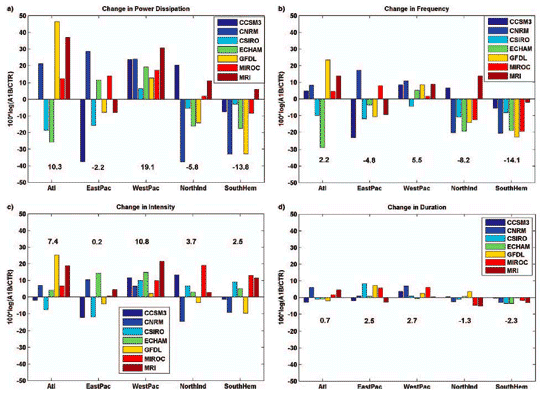Like global sea level rise, climate change impacts on tropical cyclone activity could have profound societal and environmental implications. And, as with global sea level rise, impacts of tropical cyclone activity represent a substantial challenge scientifically, as there are many uncertainties that are involved. Tropical cyclones occur at spatial scales that are not well resolved by current generation climate models. Various approaches have been used to try to get around this problem, and you can find a discussion by your course author of the relative merits of these different approaches on the RealClimate website.
One approach has been to take a finer-scale atmospheric model that is capable of producing tropical cyclone or at least tropical cyclone-like disturbances, and nest it within a larger-scale climate model. The large-scale boundary conditions from the climate model simulation are then used to drive the storm-resolving model. However, the storm-resolving models used do not generally resolve the critical inner core region of the tropical cyclone, and the cyclones produced are not especially realistic. The models, for these reasons, cannot reproduce major hurricanes (category 4 or 5), and, for this reason, one might call into question their ability to capture changes in hurricane behavior associated with climate change.
An alternative approach used by hurricane scientist Kerry Emanuel of MIT employs embedded modeling. Small-scale disturbances, similar to those that generate real-world tropical cyclones, are randomly distributed in a climate model in a way that mimics the distribution of real world disturbances. Some of these disturbances will find themselves in a favorable environment, others will not—that is determined by the large-scale climate as represented by the climate model. A finely resolved dynamical model, that does indeed resolve the key inner core structure of a tropical storm, is embedded within the climate model and is used to track each such disturbance and model any potential development and intensification. Using this approach, Emanuel is able to closely match the observed tropical cyclone climatologies (i.e., the numbers and intensities of tropical cyclones) in the various basins of tropical cyclone activity. He is also able to reproduce the observed trend, including the increase in tropical cyclone numbers and intensities in the Atlantic in recent decades, when he uses the actual large-scale observations—in place of a climate model simulation—to drive his model of tropical cyclone genesis and intensification.
So, what results does this approach yield when driven with projections of future climate change? The results of the analysis are shown below. What we see, first of all, is that there is quite a bit of variability in the results you get, depending on (a) which particular climate model projection is used and (b) which particular tropical cyclone-producing basin you are looking at. Globally, the number of tropical cyclones may actually decrease, but the power dissipation and intensity are projected to increase globally. We are particularly interested in Atlantic tropical cyclones and hurricanes, since they pose the greatest threat as far as North American impacts are concerned.

We see that majority of the models yield a substantial increase in power/intensity of Atlantic tropical cyclones. A majority also indicate an increase in the number of Atlantic tropical cyclones, but this is highly variable, with at least one of the seven models examined indicating a substantial decrease. The divergence among the various projections of the different models reflects the competition between factors favoring increased power and activity—e.g., warmer oceans and greater energy for driving storms—and other factors, such as changes in atmospheric conditions influencing, e.g., vertical wind shear, that are tied to dynamical changes in the climate system. In particular, the uncertainty in projecting changes in ENSO dynamics (from Lesson 7) comes into play here. El Niño events are associated with increased wind shear over key regions of the Caribbean and tropical Atlantic where tropical cyclone tend to form, so a more El Niño-like climate would tend to mitigate any increases in Atlantic tropical cyclone activity. By contrast, a more La Niña-like climate would mean an even more favorable atmospheric environment. So, the current uncertainty in projecting changes in ENSO and the Walker Circulation translate to uncertainties in projecting future changes in Atlantic tropical cyclone activity.
Yet, an entirely different approach to projecting changes in tropical cyclone activity involves the use of a semi-empirical approach similar in spirit to the semi-empirical modeling approach we encountered in our study of sea level rise projections in the previous section. The semi-empirical approach involves, once again, using a statistical model to relate the phenomenon of interest (tropical cyclone activity) to the climate factors we know appear to govern year-to-year changes in activity today (e.g., tropical Atlantic SSTs, El Niño, and the North Atlantic Oscillation). In fact, you may recall that this is the very same statistical model that you constructed yourself in problem set #2 using these three factors as predictors of Atlantic annual tropical cyclone numbers in a multivariate regression. That approach has been validated, to some extent, by comparisons of predictions of pre-historical changes in Atlantic tropical cyclone activity with geological records of Atlantic tropical cyclone activity spanning the past millennium. You can hear about some work the course author has done in this area in this NSF video press conference.
The statistical model referenced in the previous paragraph reveals that there is a negative correlation between ENSO index and Atlantic tropical cyclone activity (i.e., a more positive ENSO index value, or more El Niño-like conditions, is associated with lower Atlantic tropical cyclone activity), a positive correlation between tropical Atlantic SSTs and Atlantic tropical cyclone activity (i.e., higher tropical Atlantic SSTs are associated with higher Atlantic tropical cyclone activity), and a tenuous relationship between North Atlantic Oscillation and Atlantic tropical cyclone activity.
